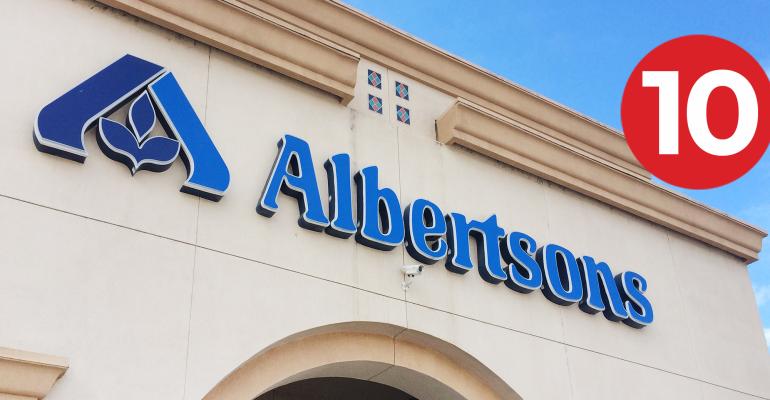- Treasury Department to Ask Insurers for Data on Climate Risks to Measure Coverage Affordability “In a proposal, the Federal Insurance Office says it plans to gather information from major insurers in every ZIP code across the country for the last five years to establish where climate change is making insurance for property owners unaffordable or inaccessible. The power to gather data on climate-related financial risks was granted under the 2010 Dodd-Frank Act, which introduced new regulations for Wall Street.” (The New York Times)
- Real Estate Investors Circle as Property Funds Offload Offices and Warehouses “There is a gap between buyers and sellers on what constitutes fair value.” (Financial Times)
- Albertsons Sale Rise Nearly 9% on Higher Prices “Albertsons Cos. posted an 8.5% rise in revenue in its recently completed quarter as higher prices boosted its same-store sales. The results come just days after rival Kroger Co. said it planned to buy Albertsons in a deal valuing the Boise, Idaho, supermarket chain at $24.6 billion. Albertsons, which operates supermarket banners such as Safeway, Shaw’s and Acme, said Tuesday that quarterly sales came in at $17.9 billion, up from $16.5 billion in the same period a year earlier. Same-store sales rose 7.4% largely due to price increases. Wall Street analysts had been expecting $17.7 billion, according to FactSet.” (The Wall Street Journal)
- Demand for Prefabricated Apartments Climbs as Costs Balloon for Multifamily Development “Construction of prefabricated homes is ramping up and providing an alternative to traditional multifamily, where the construction process has slowed because of rising costs and supply-chain delays. Prefabricated construction, which includes modular, manufactured and mobile homes, has for years been used in lower-budget housing development. But with rising interest rates and higher prices for materials such as lumber, the process is starting to get more of a toehold in the mainstream apartment market.” (The Wall Street Journal)
- Why Landlords Are Excited About Imminent Rent Law Ruling “When landlords groups challenged New York’s rent law, they expected to fail upwards. The next defeat in that plan is about to happen. The Rent Stabilization Association and the Community Housing Improvement Program in 2019 challenged the state’s new rent stabilization law as unconstitutional. From the beginning, the groups had their sights on the U.S. Supreme Court, figuring they would take their lumps on the way there.” (The Real Deal)
- Rent Control Heats Up Amid Challenges from Industry “Kingston, N.Y., a picturesque town on the Hudson River 90 miles north of New York City, could be a sign of challenges ahead for the multifamily industry. In August, Kingston became the first city in upstate New York to adopt rent control. Declaring a housing emergency under the state Emergency Tenant Protection Act, the Kingston Common Council voted to adopt rent stabilization.” (Multifamily Real Estate News)
- Rent-Setting Algorithms Could Exacerbate Rising Rents: Report “Why is the rent so high? The secret is in the sauce. And the secret may be RealPage’s YieldStar software, which is becoming increasingly ubiquitous among landlords across the country, according to an investigation by ProPublica.” (Commercial Observer)
- ‘Pay to Play’: Los Angeles’ Industrial Market Keeps Climbing “With vacancy rates that have spent months threatening to scrape 0%, leasing industrial properties in the Los Angeles and Inland Empire markets is more expensive than ever. Asking rents are up 23.6% year-to-date, according to a third-quarter report from JLL, with the newest and highest-quality properties in some cases drawing $2 per SF or more.” (Bisnow)
- Yes, S.F. Could Turn Downtown Offices into Housing. Here’s What It Would Take. “The city’s center is dominated by commercial space that remains hollowed out by the ongoing switch to remote work, landing San Francisco at the bottom of metrics for post-pandemic recovery of downtowns nationwide. An influx of people living there, urban planners say, could foster a walkable community with a more sustainable economic ecosystem of new grocery stores, pharmacies and other retail stores in place of businesses that shuttered during the pandemic.” (San Francisco Chronicle)
- New York City Enters ‘New Normal’ for Foot Traffic: Report “Less foot traffic in New York City’s downtown areas may be the new normal, according to a report from retail data analytics firm Springboard. Downtown foot traffic in New York City in September was 26.8 percent below the same month in 2019, before the pandemic, and less than the city saw in August 2022, according to the report. The slow recovery to shopping areas including Midtown, SoHo and Fort Greene, Brooklyn, comes even as employers have pushed workers to return to the office this fall.” (Commercial Observer)
0 comments
Hide comments





